Economic Principles and Decision Making
VerifiedAdded on 2023/01/12
|12
|3362
|63
AI Summary
This report explains the working of First Home owner grant and analyzes the demand and supply factors in the economy. It also discusses the market structure of FHOG and the impact of stamp duty removal on housing policies.
Contribute Materials
Your contribution can guide someone’s learning journey. Share your
documents today.
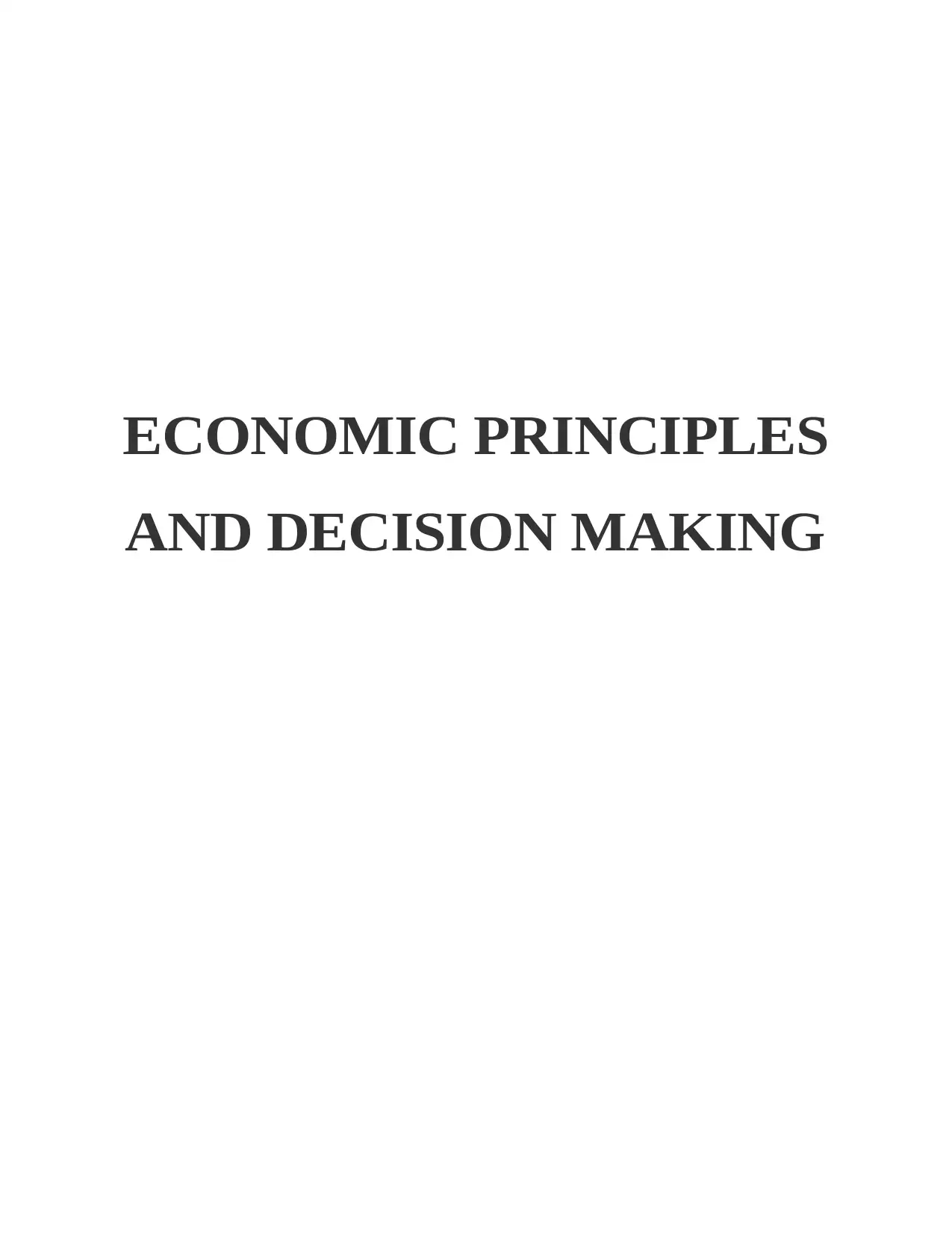
ECONOMIC PRINCIPLES
AND DECISION MAKING
AND DECISION MAKING
Secure Best Marks with AI Grader
Need help grading? Try our AI Grader for instant feedback on your assignments.
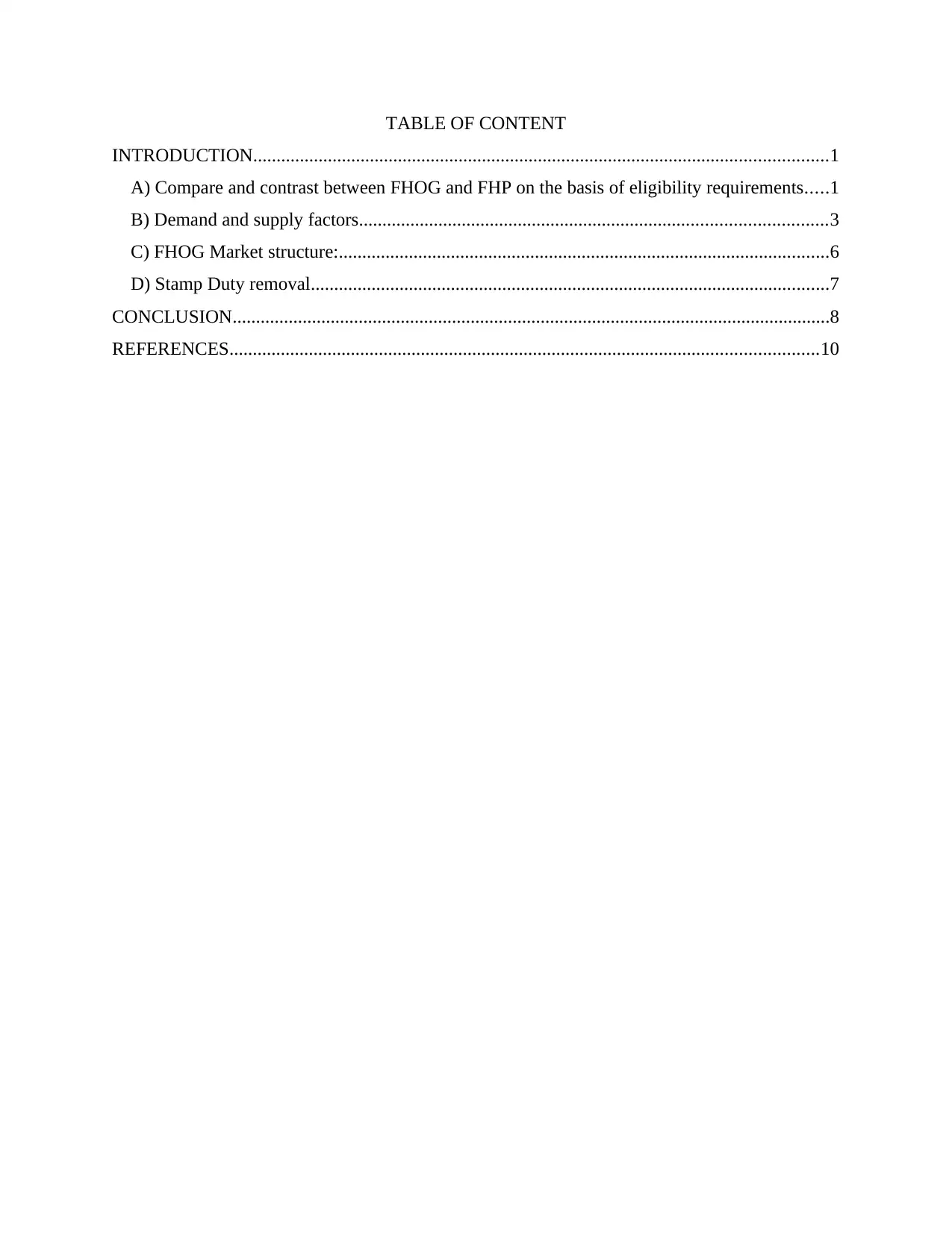
TABLE OF CONTENT
INTRODUCTION...........................................................................................................................1
A) Compare and contrast between FHOG and FHP on the basis of eligibility requirements.....1
B) Demand and supply factors....................................................................................................3
C) FHOG Market structure:.........................................................................................................6
D) Stamp Duty removal...............................................................................................................7
CONCLUSION................................................................................................................................8
REFERENCES..............................................................................................................................10
INTRODUCTION...........................................................................................................................1
A) Compare and contrast between FHOG and FHP on the basis of eligibility requirements.....1
B) Demand and supply factors....................................................................................................3
C) FHOG Market structure:.........................................................................................................6
D) Stamp Duty removal...............................................................................................................7
CONCLUSION................................................................................................................................8
REFERENCES..............................................................................................................................10
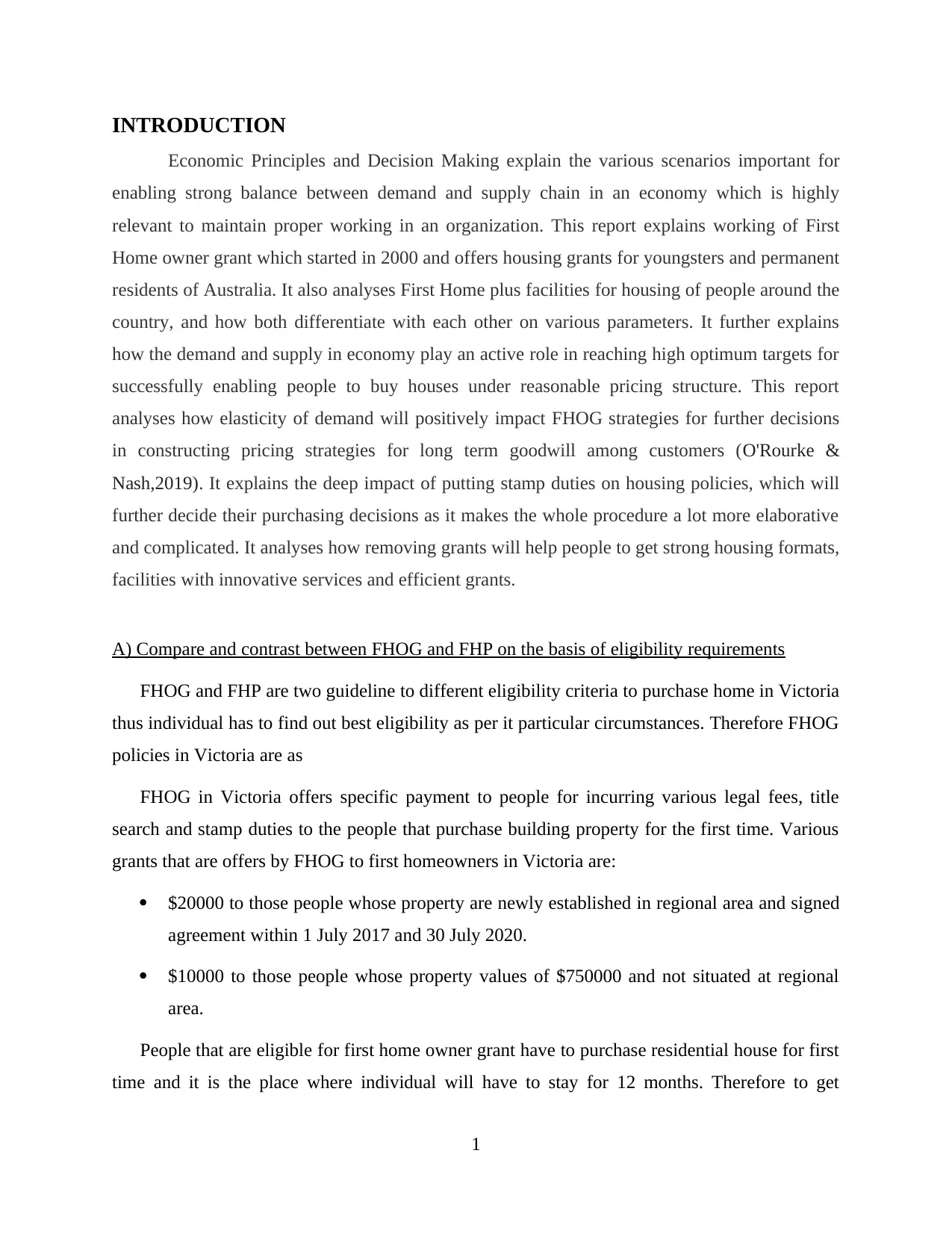
INTRODUCTION
Economic Principles and Decision Making explain the various scenarios important for
enabling strong balance between demand and supply chain in an economy which is highly
relevant to maintain proper working in an organization. This report explains working of First
Home owner grant which started in 2000 and offers housing grants for youngsters and permanent
residents of Australia. It also analyses First Home plus facilities for housing of people around the
country, and how both differentiate with each other on various parameters. It further explains
how the demand and supply in economy play an active role in reaching high optimum targets for
successfully enabling people to buy houses under reasonable pricing structure. This report
analyses how elasticity of demand will positively impact FHOG strategies for further decisions
in constructing pricing strategies for long term goodwill among customers (O'Rourke &
Nash,2019). It explains the deep impact of putting stamp duties on housing policies, which will
further decide their purchasing decisions as it makes the whole procedure a lot more elaborative
and complicated. It analyses how removing grants will help people to get strong housing formats,
facilities with innovative services and efficient grants.
A) Compare and contrast between FHOG and FHP on the basis of eligibility requirements
FHOG and FHP are two guideline to different eligibility criteria to purchase home in Victoria
thus individual has to find out best eligibility as per it particular circumstances. Therefore FHOG
policies in Victoria are as
FHOG in Victoria offers specific payment to people for incurring various legal fees, title
search and stamp duties to the people that purchase building property for the first time. Various
grants that are offers by FHOG to first homeowners in Victoria are:
$20000 to those people whose property are newly established in regional area and signed
agreement within 1 July 2017 and 30 July 2020.
$10000 to those people whose property values of $750000 and not situated at regional
area.
People that are eligible for first home owner grant have to purchase residential house for first
time and it is the place where individual will have to stay for 12 months. Therefore to get
1
Economic Principles and Decision Making explain the various scenarios important for
enabling strong balance between demand and supply chain in an economy which is highly
relevant to maintain proper working in an organization. This report explains working of First
Home owner grant which started in 2000 and offers housing grants for youngsters and permanent
residents of Australia. It also analyses First Home plus facilities for housing of people around the
country, and how both differentiate with each other on various parameters. It further explains
how the demand and supply in economy play an active role in reaching high optimum targets for
successfully enabling people to buy houses under reasonable pricing structure. This report
analyses how elasticity of demand will positively impact FHOG strategies for further decisions
in constructing pricing strategies for long term goodwill among customers (O'Rourke &
Nash,2019). It explains the deep impact of putting stamp duties on housing policies, which will
further decide their purchasing decisions as it makes the whole procedure a lot more elaborative
and complicated. It analyses how removing grants will help people to get strong housing formats,
facilities with innovative services and efficient grants.
A) Compare and contrast between FHOG and FHP on the basis of eligibility requirements
FHOG and FHP are two guideline to different eligibility criteria to purchase home in Victoria
thus individual has to find out best eligibility as per it particular circumstances. Therefore FHOG
policies in Victoria are as
FHOG in Victoria offers specific payment to people for incurring various legal fees, title
search and stamp duties to the people that purchase building property for the first time. Various
grants that are offers by FHOG to first homeowners in Victoria are:
$20000 to those people whose property are newly established in regional area and signed
agreement within 1 July 2017 and 30 July 2020.
$10000 to those people whose property values of $750000 and not situated at regional
area.
People that are eligible for first home owner grant have to purchase residential house for first
time and it is the place where individual will have to stay for 12 months. Therefore to get
1
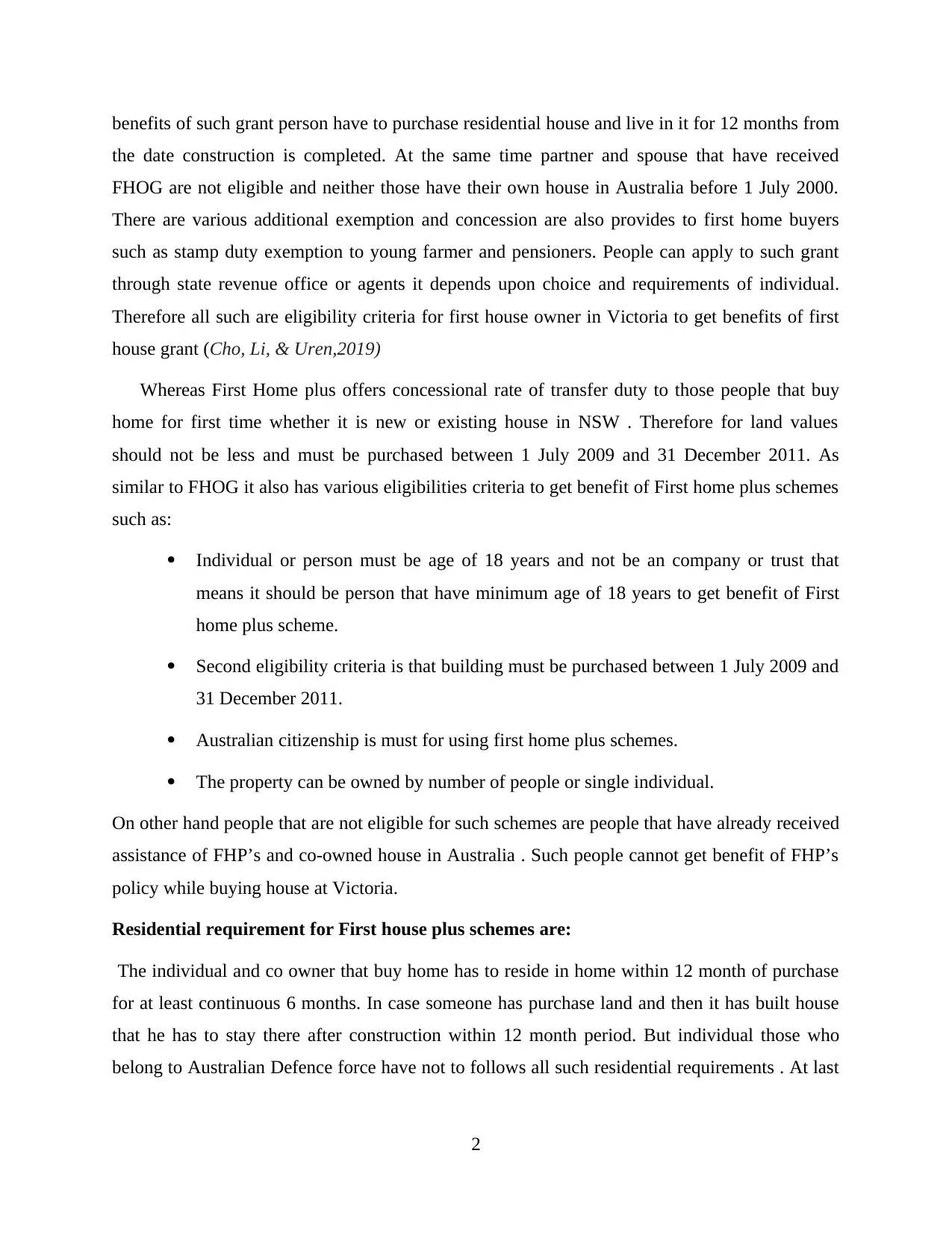
benefits of such grant person have to purchase residential house and live in it for 12 months from
the date construction is completed. At the same time partner and spouse that have received
FHOG are not eligible and neither those have their own house in Australia before 1 July 2000.
There are various additional exemption and concession are also provides to first home buyers
such as stamp duty exemption to young farmer and pensioners. People can apply to such grant
through state revenue office or agents it depends upon choice and requirements of individual.
Therefore all such are eligibility criteria for first house owner in Victoria to get benefits of first
house grant (Cho, Li, & Uren,2019)
Whereas First Home plus offers concessional rate of transfer duty to those people that buy
home for first time whether it is new or existing house in NSW . Therefore for land values
should not be less and must be purchased between 1 July 2009 and 31 December 2011. As
similar to FHOG it also has various eligibilities criteria to get benefit of First home plus schemes
such as:
Individual or person must be age of 18 years and not be an company or trust that
means it should be person that have minimum age of 18 years to get benefit of First
home plus scheme.
Second eligibility criteria is that building must be purchased between 1 July 2009 and
31 December 2011.
Australian citizenship is must for using first home plus schemes.
The property can be owned by number of people or single individual.
On other hand people that are not eligible for such schemes are people that have already received
assistance of FHP’s and co-owned house in Australia . Such people cannot get benefit of FHP’s
policy while buying house at Victoria.
Residential requirement for First house plus schemes are:
The individual and co owner that buy home has to reside in home within 12 month of purchase
for at least continuous 6 months. In case someone has purchase land and then it has built house
that he has to stay there after construction within 12 month period. But individual those who
belong to Australian Defence force have not to follows all such residential requirements . At last
2
the date construction is completed. At the same time partner and spouse that have received
FHOG are not eligible and neither those have their own house in Australia before 1 July 2000.
There are various additional exemption and concession are also provides to first home buyers
such as stamp duty exemption to young farmer and pensioners. People can apply to such grant
through state revenue office or agents it depends upon choice and requirements of individual.
Therefore all such are eligibility criteria for first house owner in Victoria to get benefits of first
house grant (Cho, Li, & Uren,2019)
Whereas First Home plus offers concessional rate of transfer duty to those people that buy
home for first time whether it is new or existing house in NSW . Therefore for land values
should not be less and must be purchased between 1 July 2009 and 31 December 2011. As
similar to FHOG it also has various eligibilities criteria to get benefit of First home plus schemes
such as:
Individual or person must be age of 18 years and not be an company or trust that
means it should be person that have minimum age of 18 years to get benefit of First
home plus scheme.
Second eligibility criteria is that building must be purchased between 1 July 2009 and
31 December 2011.
Australian citizenship is must for using first home plus schemes.
The property can be owned by number of people or single individual.
On other hand people that are not eligible for such schemes are people that have already received
assistance of FHP’s and co-owned house in Australia . Such people cannot get benefit of FHP’s
policy while buying house at Victoria.
Residential requirement for First house plus schemes are:
The individual and co owner that buy home has to reside in home within 12 month of purchase
for at least continuous 6 months. In case someone has purchase land and then it has built house
that he has to stay there after construction within 12 month period. But individual those who
belong to Australian Defence force have not to follows all such residential requirements . At last
2
Secure Best Marks with AI Grader
Need help grading? Try our AI Grader for instant feedback on your assignments.
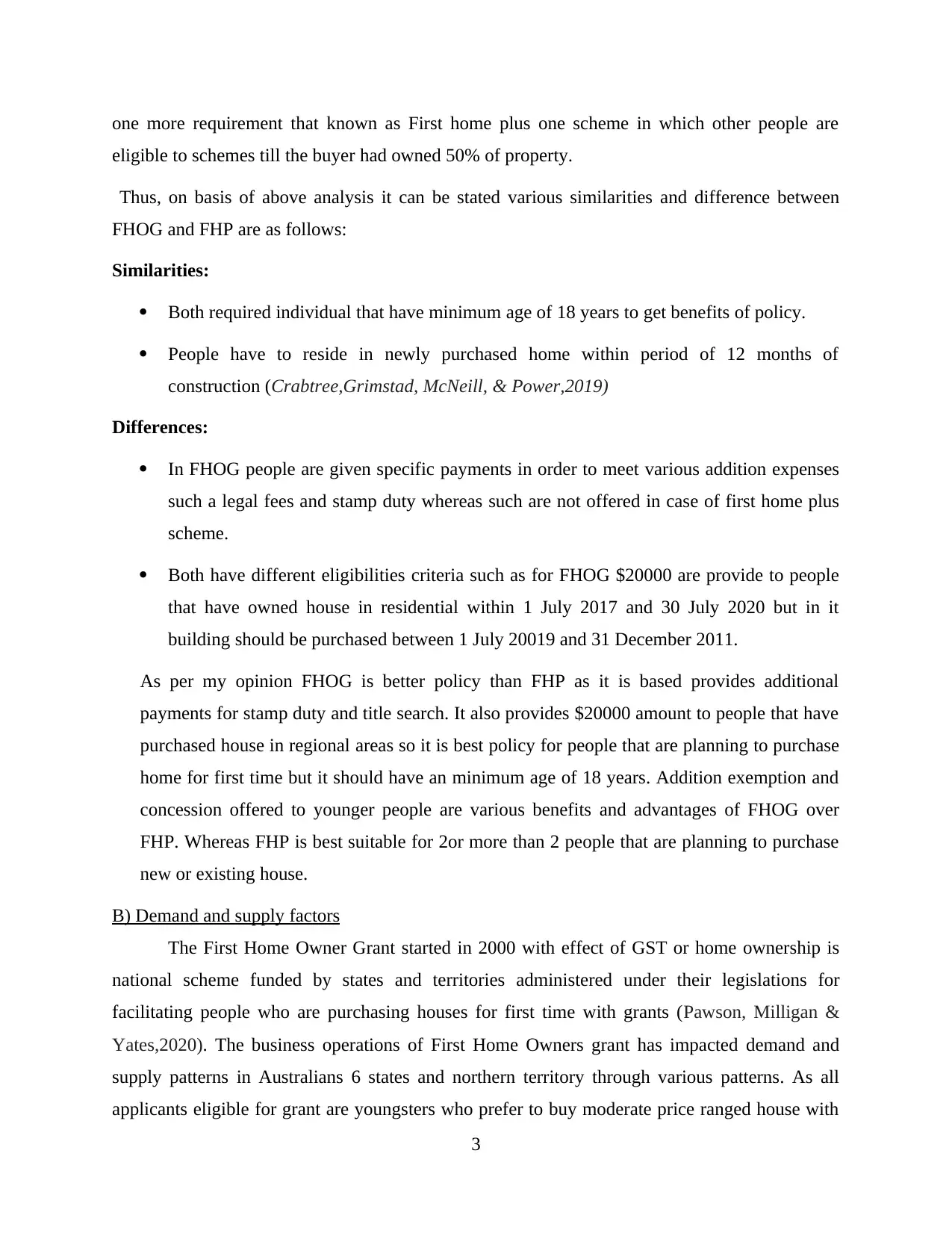
one more requirement that known as First home plus one scheme in which other people are
eligible to schemes till the buyer had owned 50% of property.
Thus, on basis of above analysis it can be stated various similarities and difference between
FHOG and FHP are as follows:
Similarities:
Both required individual that have minimum age of 18 years to get benefits of policy.
People have to reside in newly purchased home within period of 12 months of
construction (Crabtree,Grimstad, McNeill, & Power,2019)
Differences:
In FHOG people are given specific payments in order to meet various addition expenses
such a legal fees and stamp duty whereas such are not offered in case of first home plus
scheme.
Both have different eligibilities criteria such as for FHOG $20000 are provide to people
that have owned house in residential within 1 July 2017 and 30 July 2020 but in it
building should be purchased between 1 July 20019 and 31 December 2011.
As per my opinion FHOG is better policy than FHP as it is based provides additional
payments for stamp duty and title search. It also provides $20000 amount to people that have
purchased house in regional areas so it is best policy for people that are planning to purchase
home for first time but it should have an minimum age of 18 years. Addition exemption and
concession offered to younger people are various benefits and advantages of FHOG over
FHP. Whereas FHP is best suitable for 2or more than 2 people that are planning to purchase
new or existing house.
B) Demand and supply factors
The First Home Owner Grant started in 2000 with effect of GST or home ownership is
national scheme funded by states and territories administered under their legislations for
facilitating people who are purchasing houses for first time with grants (Pawson, Milligan &
Yates,2020). The business operations of First Home Owners grant has impacted demand and
supply patterns in Australians 6 states and northern territory through various patterns. As all
applicants eligible for grant are youngsters who prefer to buy moderate price ranged house with
3
eligible to schemes till the buyer had owned 50% of property.
Thus, on basis of above analysis it can be stated various similarities and difference between
FHOG and FHP are as follows:
Similarities:
Both required individual that have minimum age of 18 years to get benefits of policy.
People have to reside in newly purchased home within period of 12 months of
construction (Crabtree,Grimstad, McNeill, & Power,2019)
Differences:
In FHOG people are given specific payments in order to meet various addition expenses
such a legal fees and stamp duty whereas such are not offered in case of first home plus
scheme.
Both have different eligibilities criteria such as for FHOG $20000 are provide to people
that have owned house in residential within 1 July 2017 and 30 July 2020 but in it
building should be purchased between 1 July 20019 and 31 December 2011.
As per my opinion FHOG is better policy than FHP as it is based provides additional
payments for stamp duty and title search. It also provides $20000 amount to people that have
purchased house in regional areas so it is best policy for people that are planning to purchase
home for first time but it should have an minimum age of 18 years. Addition exemption and
concession offered to younger people are various benefits and advantages of FHOG over
FHP. Whereas FHP is best suitable for 2or more than 2 people that are planning to purchase
new or existing house.
B) Demand and supply factors
The First Home Owner Grant started in 2000 with effect of GST or home ownership is
national scheme funded by states and territories administered under their legislations for
facilitating people who are purchasing houses for first time with grants (Pawson, Milligan &
Yates,2020). The business operations of First Home Owners grant has impacted demand and
supply patterns in Australians 6 states and northern territory through various patterns. As all
applicants eligible for grant are youngsters who prefer to buy moderate price ranged house with
3
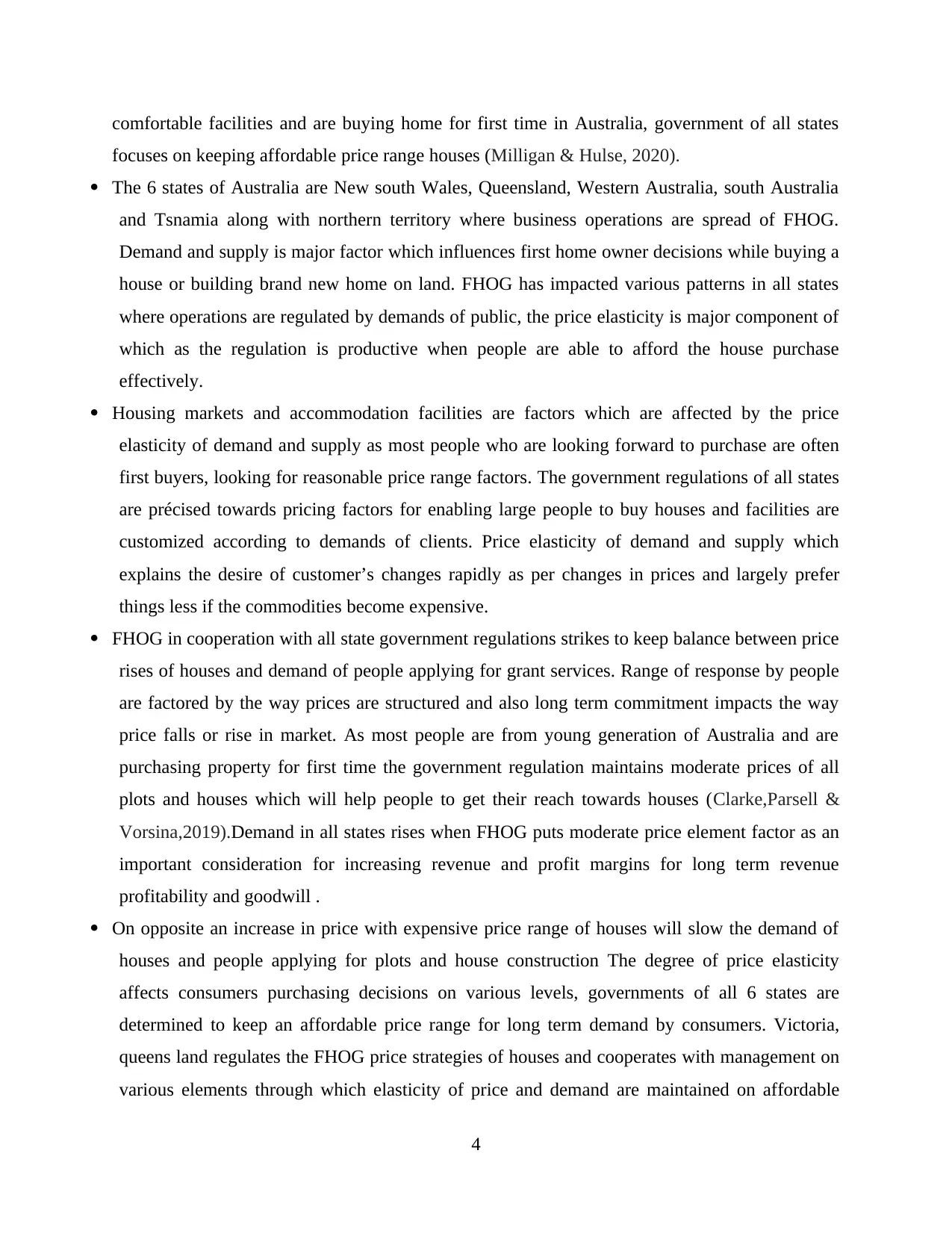
comfortable facilities and are buying home for first time in Australia, government of all states
focuses on keeping affordable price range houses (Milligan & Hulse, 2020).
The 6 states of Australia are New south Wales, Queensland, Western Australia, south Australia
and Tsnamia along with northern territory where business operations are spread of FHOG.
Demand and supply is major factor which influences first home owner decisions while buying a
house or building brand new home on land. FHOG has impacted various patterns in all states
where operations are regulated by demands of public, the price elasticity is major component of
which as the regulation is productive when people are able to afford the house purchase
effectively.
Housing markets and accommodation facilities are factors which are affected by the price
elasticity of demand and supply as most people who are looking forward to purchase are often
first buyers, looking for reasonable price range factors. The government regulations of all states
are précised towards pricing factors for enabling large people to buy houses and facilities are
customized according to demands of clients. Price elasticity of demand and supply which
explains the desire of customer’s changes rapidly as per changes in prices and largely prefer
things less if the commodities become expensive.
FHOG in cooperation with all state government regulations strikes to keep balance between price
rises of houses and demand of people applying for grant services. Range of response by people
are factored by the way prices are structured and also long term commitment impacts the way
price falls or rise in market. As most people are from young generation of Australia and are
purchasing property for first time the government regulation maintains moderate prices of all
plots and houses which will help people to get their reach towards houses (Clarke,Parsell &
Vorsina,2019).Demand in all states rises when FHOG puts moderate price element factor as an
important consideration for increasing revenue and profit margins for long term revenue
profitability and goodwill .
On opposite an increase in price with expensive price range of houses will slow the demand of
houses and people applying for plots and house construction The degree of price elasticity
affects consumers purchasing decisions on various levels, governments of all 6 states are
determined to keep an affordable price range for long term demand by consumers. Victoria,
queens land regulates the FHOG price strategies of houses and cooperates with management on
various elements through which elasticity of price and demand are maintained on affordable
4
focuses on keeping affordable price range houses (Milligan & Hulse, 2020).
The 6 states of Australia are New south Wales, Queensland, Western Australia, south Australia
and Tsnamia along with northern territory where business operations are spread of FHOG.
Demand and supply is major factor which influences first home owner decisions while buying a
house or building brand new home on land. FHOG has impacted various patterns in all states
where operations are regulated by demands of public, the price elasticity is major component of
which as the regulation is productive when people are able to afford the house purchase
effectively.
Housing markets and accommodation facilities are factors which are affected by the price
elasticity of demand and supply as most people who are looking forward to purchase are often
first buyers, looking for reasonable price range factors. The government regulations of all states
are précised towards pricing factors for enabling large people to buy houses and facilities are
customized according to demands of clients. Price elasticity of demand and supply which
explains the desire of customer’s changes rapidly as per changes in prices and largely prefer
things less if the commodities become expensive.
FHOG in cooperation with all state government regulations strikes to keep balance between price
rises of houses and demand of people applying for grant services. Range of response by people
are factored by the way prices are structured and also long term commitment impacts the way
price falls or rise in market. As most people are from young generation of Australia and are
purchasing property for first time the government regulation maintains moderate prices of all
plots and houses which will help people to get their reach towards houses (Clarke,Parsell &
Vorsina,2019).Demand in all states rises when FHOG puts moderate price element factor as an
important consideration for increasing revenue and profit margins for long term revenue
profitability and goodwill .
On opposite an increase in price with expensive price range of houses will slow the demand of
houses and people applying for plots and house construction The degree of price elasticity
affects consumers purchasing decisions on various levels, governments of all 6 states are
determined to keep an affordable price range for long term demand by consumers. Victoria,
queens land regulates the FHOG price strategies of houses and cooperates with management on
various elements through which elasticity of price and demand are maintained on affordable
4

range. Prices are structured within the range of supply to facilitate customers to purchase their
houses and the various parameters through which they can be determined to facilitate affordable
services. The qualities of facilities are determined with the official goal of FHOG where
management promises its customers with high delivery of facilities, leverage strong goodwill
and an increased potential to buy which enhances their purchasing decisions (Clarke,Watts, &
Parsell,2019)
5
houses and the various parameters through which they can be determined to facilitate affordable
services. The qualities of facilities are determined with the official goal of FHOG where
management promises its customers with high delivery of facilities, leverage strong goodwill
and an increased potential to buy which enhances their purchasing decisions (Clarke,Watts, &
Parsell,2019)
5
Paraphrase This Document
Need a fresh take? Get an instant paraphrase of this document with our AI Paraphraser
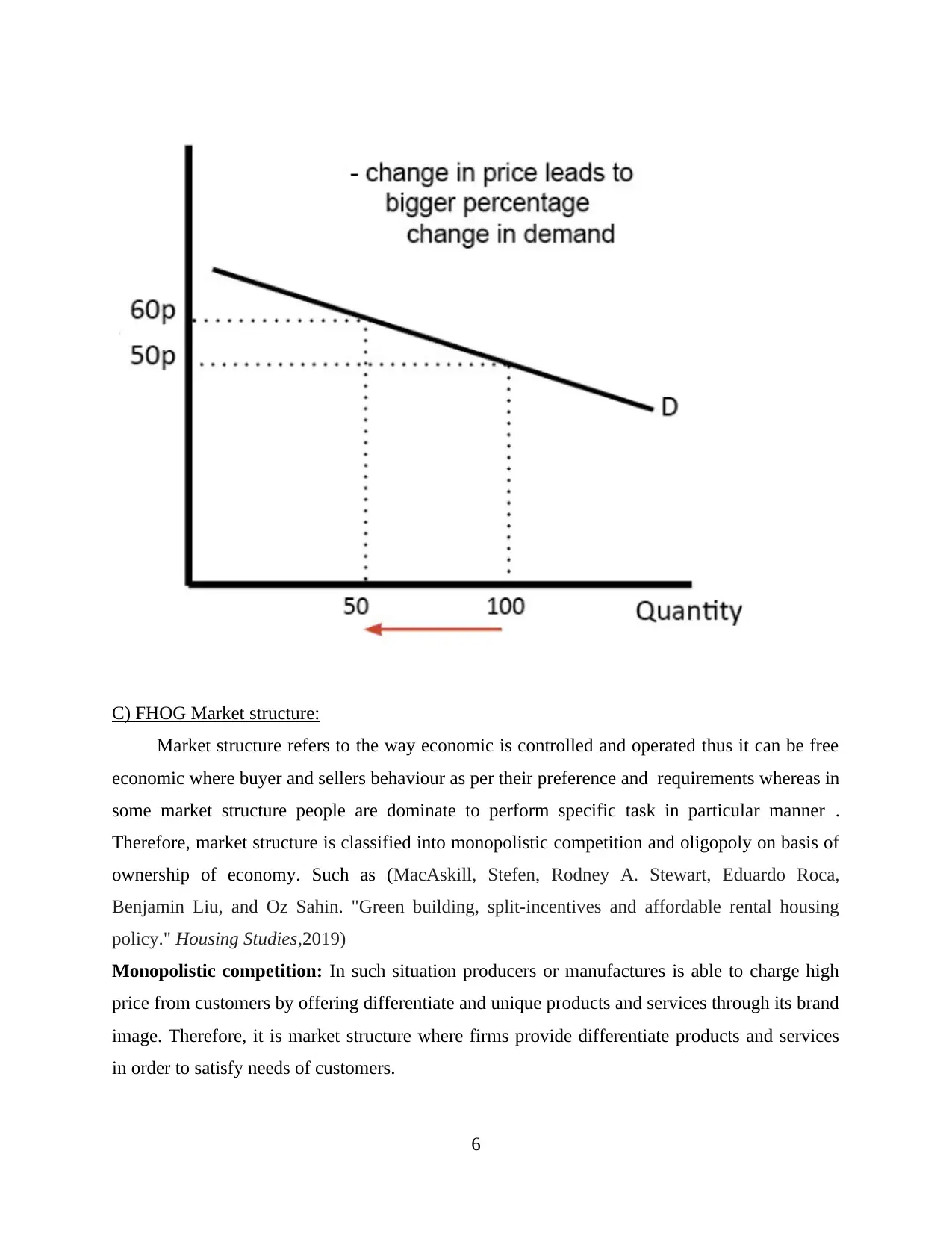
C) FHOG Market structure:
Market structure refers to the way economic is controlled and operated thus it can be free
economic where buyer and sellers behaviour as per their preference and requirements whereas in
some market structure people are dominate to perform specific task in particular manner .
Therefore, market structure is classified into monopolistic competition and oligopoly on basis of
ownership of economy. Such as (MacAskill, Stefen, Rodney A. Stewart, Eduardo Roca,
Benjamin Liu, and Oz Sahin. "Green building, split-incentives and affordable rental housing
policy." Housing Studies,2019)
Monopolistic competition: In such situation producers or manufactures is able to charge high
price from customers by offering differentiate and unique products and services through its brand
image. Therefore, it is market structure where firms provide differentiate products and services
in order to satisfy needs of customers.
6
Market structure refers to the way economic is controlled and operated thus it can be free
economic where buyer and sellers behaviour as per their preference and requirements whereas in
some market structure people are dominate to perform specific task in particular manner .
Therefore, market structure is classified into monopolistic competition and oligopoly on basis of
ownership of economy. Such as (MacAskill, Stefen, Rodney A. Stewart, Eduardo Roca,
Benjamin Liu, and Oz Sahin. "Green building, split-incentives and affordable rental housing
policy." Housing Studies,2019)
Monopolistic competition: In such situation producers or manufactures is able to charge high
price from customers by offering differentiate and unique products and services through its brand
image. Therefore, it is market structure where firms provide differentiate products and services
in order to satisfy needs of customers.
6
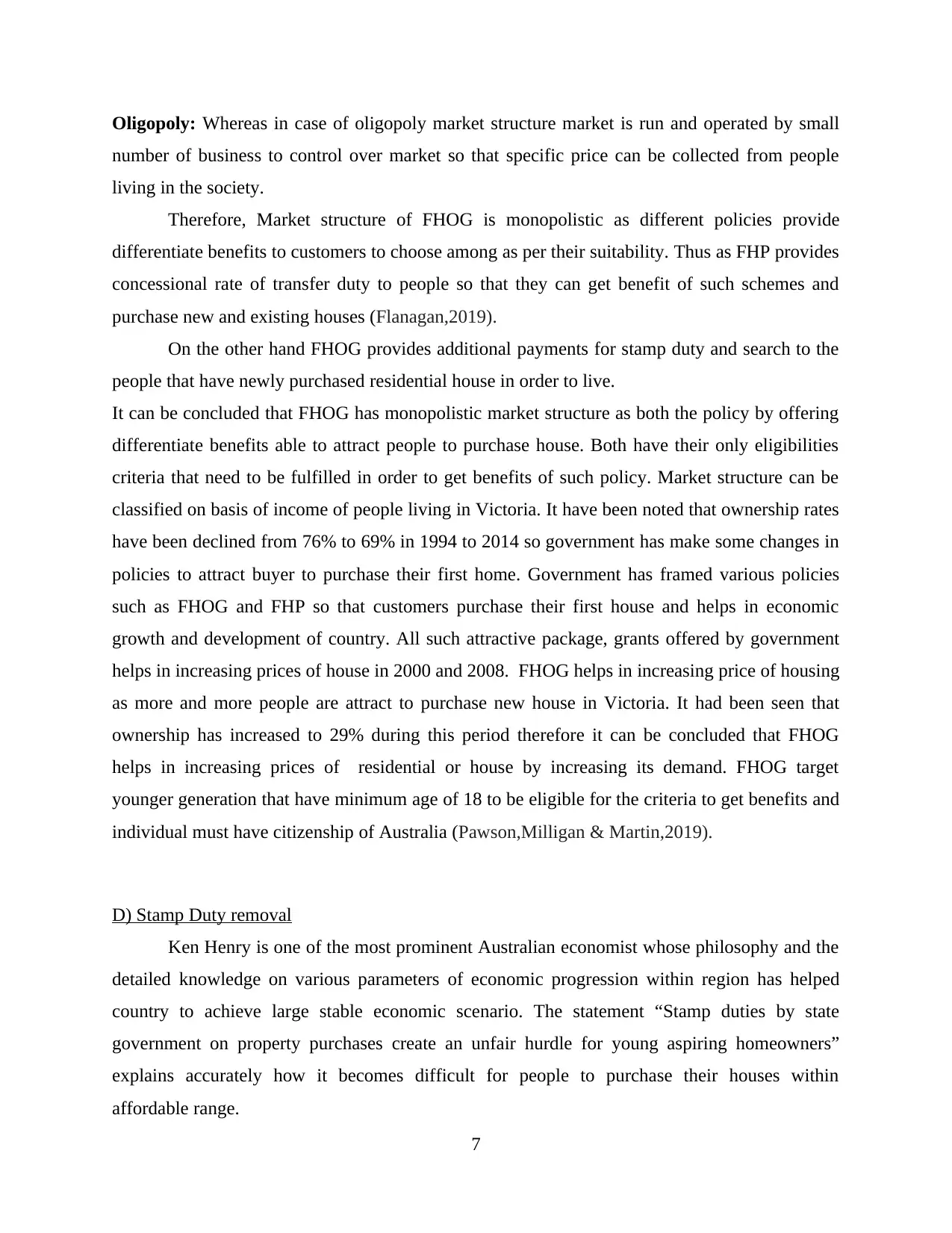
Oligopoly: Whereas in case of oligopoly market structure market is run and operated by small
number of business to control over market so that specific price can be collected from people
living in the society.
Therefore, Market structure of FHOG is monopolistic as different policies provide
differentiate benefits to customers to choose among as per their suitability. Thus as FHP provides
concessional rate of transfer duty to people so that they can get benefit of such schemes and
purchase new and existing houses (Flanagan,2019).
On the other hand FHOG provides additional payments for stamp duty and search to the
people that have newly purchased residential house in order to live.
It can be concluded that FHOG has monopolistic market structure as both the policy by offering
differentiate benefits able to attract people to purchase house. Both have their only eligibilities
criteria that need to be fulfilled in order to get benefits of such policy. Market structure can be
classified on basis of income of people living in Victoria. It have been noted that ownership rates
have been declined from 76% to 69% in 1994 to 2014 so government has make some changes in
policies to attract buyer to purchase their first home. Government has framed various policies
such as FHOG and FHP so that customers purchase their first house and helps in economic
growth and development of country. All such attractive package, grants offered by government
helps in increasing prices of house in 2000 and 2008. FHOG helps in increasing price of housing
as more and more people are attract to purchase new house in Victoria. It had been seen that
ownership has increased to 29% during this period therefore it can be concluded that FHOG
helps in increasing prices of residential or house by increasing its demand. FHOG target
younger generation that have minimum age of 18 to be eligible for the criteria to get benefits and
individual must have citizenship of Australia (Pawson,Milligan & Martin,2019).
D) Stamp Duty removal
Ken Henry is one of the most prominent Australian economist whose philosophy and the
detailed knowledge on various parameters of economic progression within region has helped
country to achieve large stable economic scenario. The statement “Stamp duties by state
government on property purchases create an unfair hurdle for young aspiring homeowners”
explains accurately how it becomes difficult for people to purchase their houses within
affordable range.
7
number of business to control over market so that specific price can be collected from people
living in the society.
Therefore, Market structure of FHOG is monopolistic as different policies provide
differentiate benefits to customers to choose among as per their suitability. Thus as FHP provides
concessional rate of transfer duty to people so that they can get benefit of such schemes and
purchase new and existing houses (Flanagan,2019).
On the other hand FHOG provides additional payments for stamp duty and search to the
people that have newly purchased residential house in order to live.
It can be concluded that FHOG has monopolistic market structure as both the policy by offering
differentiate benefits able to attract people to purchase house. Both have their only eligibilities
criteria that need to be fulfilled in order to get benefits of such policy. Market structure can be
classified on basis of income of people living in Victoria. It have been noted that ownership rates
have been declined from 76% to 69% in 1994 to 2014 so government has make some changes in
policies to attract buyer to purchase their first home. Government has framed various policies
such as FHOG and FHP so that customers purchase their first house and helps in economic
growth and development of country. All such attractive package, grants offered by government
helps in increasing prices of house in 2000 and 2008. FHOG helps in increasing price of housing
as more and more people are attract to purchase new house in Victoria. It had been seen that
ownership has increased to 29% during this period therefore it can be concluded that FHOG
helps in increasing prices of residential or house by increasing its demand. FHOG target
younger generation that have minimum age of 18 to be eligible for the criteria to get benefits and
individual must have citizenship of Australia (Pawson,Milligan & Martin,2019).
D) Stamp Duty removal
Ken Henry is one of the most prominent Australian economist whose philosophy and the
detailed knowledge on various parameters of economic progression within region has helped
country to achieve large stable economic scenario. The statement “Stamp duties by state
government on property purchases create an unfair hurdle for young aspiring homeowners”
explains accurately how it becomes difficult for people to purchase their houses within
affordable range.
7

Stamp duty acts as big discomfort and procedural burden for people who wish to purchase
houses and are young and aspirant with search for an affordable price range house. When
there is heavy price levied on stamp duty, it acts as disadvantage for young generation people
who are mostly university students or are into their high school periods. As per economist
Ken Henry, FHOG must exempt youngsters and people from stamp duties who are eligible for
first home grants under policies. This step will enable more people to come forward for
purchasing houses and leveraging opportunities to buy houses as per desires, which will
attract the housing policies and various new segment customers too (Nelson,McCracken-
Hewson,Sundstrom & Hawthorne,2019).
Housing practices must have regulations of minimum stamp dusty or remove it completely,
which will enable people to connect with FHOG housing practices organization and relevantly
bring the potential buyers close to the housing practices. The economist has successfully
checked various paradigms which will help in further expansion of housing practices by
reducing and totally eliminating stamp duty as it will benefit young applicants for applying
houses.
These measures will leverage high goodwill and strong profitable in future revenues by
attracting large number of people and customers around world. Ken Henry has advised these
measures of eliminating stamp dusty on housing property purchases through organizing
cooperative structure and a smooth process for establishing convenient procedure for young
aspirants to buy houses. These facilities will help to smoothen overall scenario of purchasing
house properties and youngsters who are aspiring house buyers will get a lot advantage and
develop their purchasing behavior (Pawson,Milligan & Yates, 2020).
CONCLUSION
This report can be concluded with explanation on various factors which elaborates
functioning of First Home Owners Grant and First Home Plus facilities, with detailed
comparatively analysis of factors of both. Federal government of Australia is responsible for
assisting people to get their residential property under these housing practices which are above
18 years and are permanent residents of Australia. This report concludes the various facilities
and measures which imply under housing practices to positively impact the working scenario of
FHOG and connect customers, potential buyers with the organization. It also concludes the
8
houses and are young and aspirant with search for an affordable price range house. When
there is heavy price levied on stamp duty, it acts as disadvantage for young generation people
who are mostly university students or are into their high school periods. As per economist
Ken Henry, FHOG must exempt youngsters and people from stamp duties who are eligible for
first home grants under policies. This step will enable more people to come forward for
purchasing houses and leveraging opportunities to buy houses as per desires, which will
attract the housing policies and various new segment customers too (Nelson,McCracken-
Hewson,Sundstrom & Hawthorne,2019).
Housing practices must have regulations of minimum stamp dusty or remove it completely,
which will enable people to connect with FHOG housing practices organization and relevantly
bring the potential buyers close to the housing practices. The economist has successfully
checked various paradigms which will help in further expansion of housing practices by
reducing and totally eliminating stamp duty as it will benefit young applicants for applying
houses.
These measures will leverage high goodwill and strong profitable in future revenues by
attracting large number of people and customers around world. Ken Henry has advised these
measures of eliminating stamp dusty on housing property purchases through organizing
cooperative structure and a smooth process for establishing convenient procedure for young
aspirants to buy houses. These facilities will help to smoothen overall scenario of purchasing
house properties and youngsters who are aspiring house buyers will get a lot advantage and
develop their purchasing behavior (Pawson,Milligan & Yates, 2020).
CONCLUSION
This report can be concluded with explanation on various factors which elaborates
functioning of First Home Owners Grant and First Home Plus facilities, with detailed
comparatively analysis of factors of both. Federal government of Australia is responsible for
assisting people to get their residential property under these housing practices which are above
18 years and are permanent residents of Australia. This report concludes the various facilities
and measures which imply under housing practices to positively impact the working scenario of
FHOG and connect customers, potential buyers with the organization. It also concludes the
8
Secure Best Marks with AI Grader
Need help grading? Try our AI Grader for instant feedback on your assignments.
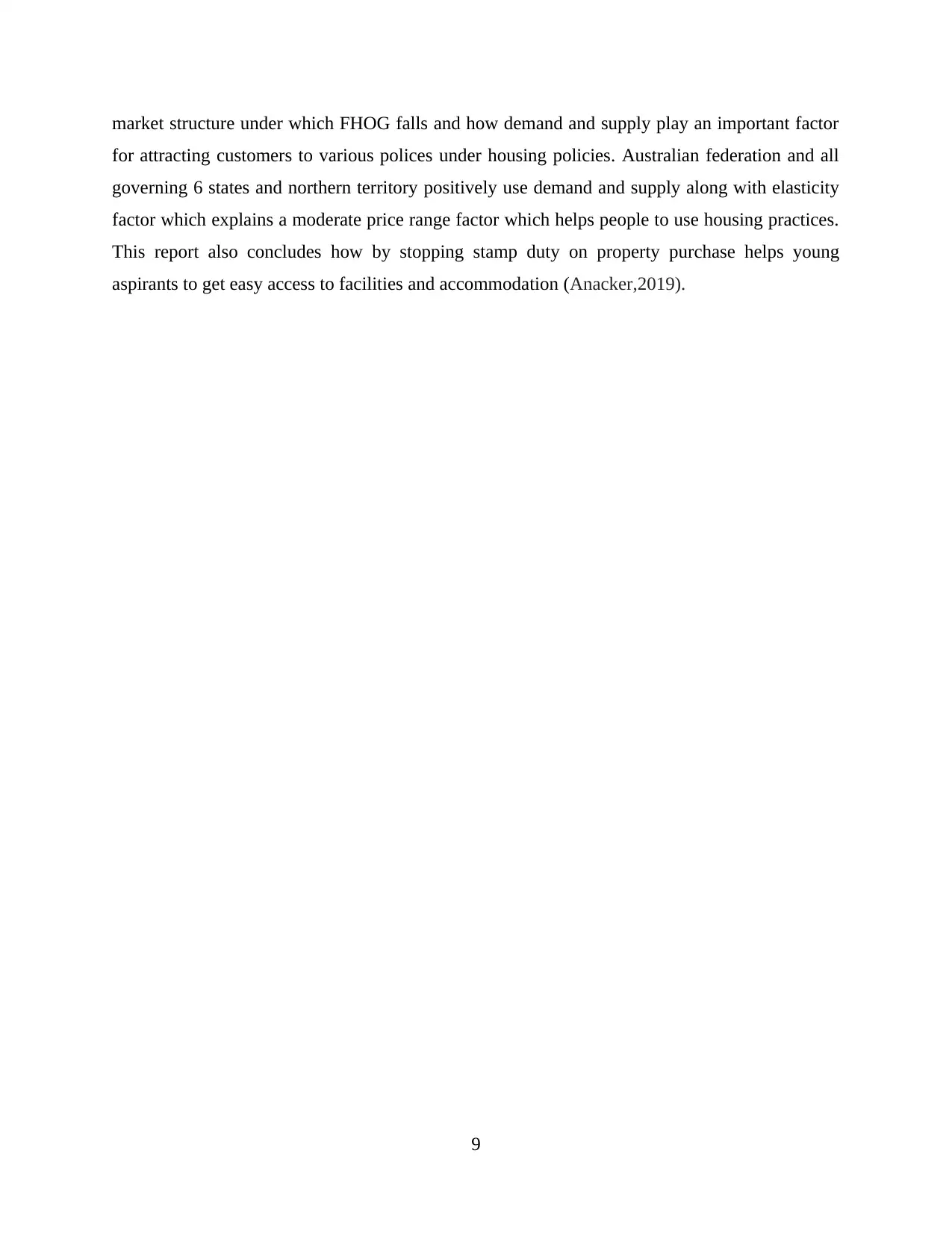
market structure under which FHOG falls and how demand and supply play an important factor
for attracting customers to various polices under housing policies. Australian federation and all
governing 6 states and northern territory positively use demand and supply along with elasticity
factor which explains a moderate price range factor which helps people to use housing practices.
This report also concludes how by stopping stamp duty on property purchase helps young
aspirants to get easy access to facilities and accommodation (Anacker,2019).
9
for attracting customers to various polices under housing policies. Australian federation and all
governing 6 states and northern territory positively use demand and supply along with elasticity
factor which explains a moderate price range factor which helps people to use housing practices.
This report also concludes how by stopping stamp duty on property purchase helps young
aspirants to get easy access to facilities and accommodation (Anacker,2019).
9
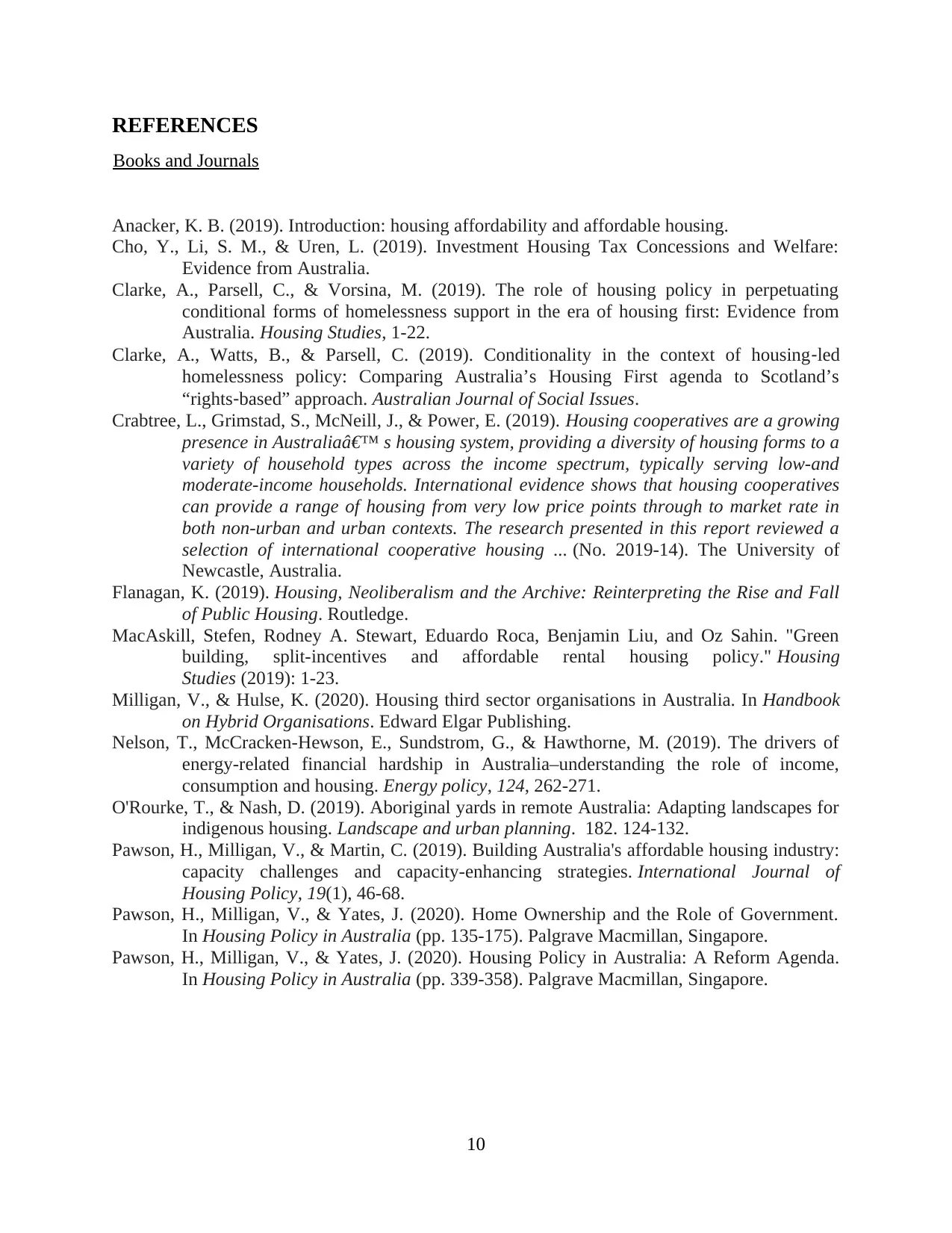
REFERENCES
Books and Journals
Anacker, K. B. (2019). Introduction: housing affordability and affordable housing.
Cho, Y., Li, S. M., & Uren, L. (2019). Investment Housing Tax Concessions and Welfare:
Evidence from Australia.
Clarke, A., Parsell, C., & Vorsina, M. (2019). The role of housing policy in perpetuating
conditional forms of homelessness support in the era of housing first: Evidence from
Australia. Housing Studies, 1-22.
Clarke, A., Watts, B., & Parsell, C. (2019). Conditionality in the context of housing‐led
homelessness policy: Comparing Australia’s Housing First agenda to Scotland’s
“rights‐based” approach. Australian Journal of Social Issues.
Crabtree, L., Grimstad, S., McNeill, J., & Power, E. (2019). Housing cooperatives are a growing
presence in Australia’ s housing system, providing a diversity of housing forms to a
variety of household types across the income spectrum, typically serving low-and
moderate-income households. International evidence shows that housing cooperatives
can provide a range of housing from very low price points through to market rate in
both non-urban and urban contexts. The research presented in this report reviewed a
selection of international cooperative housing ... (No. 2019-14). The University of
Newcastle, Australia.
Flanagan, K. (2019). Housing, Neoliberalism and the Archive: Reinterpreting the Rise and Fall
of Public Housing. Routledge.
MacAskill, Stefen, Rodney A. Stewart, Eduardo Roca, Benjamin Liu, and Oz Sahin. "Green
building, split-incentives and affordable rental housing policy." Housing
Studies (2019): 1-23.
Milligan, V., & Hulse, K. (2020). Housing third sector organisations in Australia. In Handbook
on Hybrid Organisations. Edward Elgar Publishing.
Nelson, T., McCracken-Hewson, E., Sundstrom, G., & Hawthorne, M. (2019). The drivers of
energy-related financial hardship in Australia–understanding the role of income,
consumption and housing. Energy policy, 124, 262-271.
O'Rourke, T., & Nash, D. (2019). Aboriginal yards in remote Australia: Adapting landscapes for
indigenous housing. Landscape and urban planning. 182. 124-132.
Pawson, H., Milligan, V., & Martin, C. (2019). Building Australia's affordable housing industry:
capacity challenges and capacity-enhancing strategies. International Journal of
Housing Policy, 19(1), 46-68.
Pawson, H., Milligan, V., & Yates, J. (2020). Home Ownership and the Role of Government.
In Housing Policy in Australia (pp. 135-175). Palgrave Macmillan, Singapore.
Pawson, H., Milligan, V., & Yates, J. (2020). Housing Policy in Australia: A Reform Agenda.
In Housing Policy in Australia (pp. 339-358). Palgrave Macmillan, Singapore.
10
Books and Journals
Anacker, K. B. (2019). Introduction: housing affordability and affordable housing.
Cho, Y., Li, S. M., & Uren, L. (2019). Investment Housing Tax Concessions and Welfare:
Evidence from Australia.
Clarke, A., Parsell, C., & Vorsina, M. (2019). The role of housing policy in perpetuating
conditional forms of homelessness support in the era of housing first: Evidence from
Australia. Housing Studies, 1-22.
Clarke, A., Watts, B., & Parsell, C. (2019). Conditionality in the context of housing‐led
homelessness policy: Comparing Australia’s Housing First agenda to Scotland’s
“rights‐based” approach. Australian Journal of Social Issues.
Crabtree, L., Grimstad, S., McNeill, J., & Power, E. (2019). Housing cooperatives are a growing
presence in Australia’ s housing system, providing a diversity of housing forms to a
variety of household types across the income spectrum, typically serving low-and
moderate-income households. International evidence shows that housing cooperatives
can provide a range of housing from very low price points through to market rate in
both non-urban and urban contexts. The research presented in this report reviewed a
selection of international cooperative housing ... (No. 2019-14). The University of
Newcastle, Australia.
Flanagan, K. (2019). Housing, Neoliberalism and the Archive: Reinterpreting the Rise and Fall
of Public Housing. Routledge.
MacAskill, Stefen, Rodney A. Stewart, Eduardo Roca, Benjamin Liu, and Oz Sahin. "Green
building, split-incentives and affordable rental housing policy." Housing
Studies (2019): 1-23.
Milligan, V., & Hulse, K. (2020). Housing third sector organisations in Australia. In Handbook
on Hybrid Organisations. Edward Elgar Publishing.
Nelson, T., McCracken-Hewson, E., Sundstrom, G., & Hawthorne, M. (2019). The drivers of
energy-related financial hardship in Australia–understanding the role of income,
consumption and housing. Energy policy, 124, 262-271.
O'Rourke, T., & Nash, D. (2019). Aboriginal yards in remote Australia: Adapting landscapes for
indigenous housing. Landscape and urban planning. 182. 124-132.
Pawson, H., Milligan, V., & Martin, C. (2019). Building Australia's affordable housing industry:
capacity challenges and capacity-enhancing strategies. International Journal of
Housing Policy, 19(1), 46-68.
Pawson, H., Milligan, V., & Yates, J. (2020). Home Ownership and the Role of Government.
In Housing Policy in Australia (pp. 135-175). Palgrave Macmillan, Singapore.
Pawson, H., Milligan, V., & Yates, J. (2020). Housing Policy in Australia: A Reform Agenda.
In Housing Policy in Australia (pp. 339-358). Palgrave Macmillan, Singapore.
10
1 out of 12
Related Documents
Your All-in-One AI-Powered Toolkit for Academic Success.
+13062052269
info@desklib.com
Available 24*7 on WhatsApp / Email
![[object Object]](/_next/static/media/star-bottom.7253800d.svg)
Unlock your academic potential
© 2024 | Zucol Services PVT LTD | All rights reserved.




